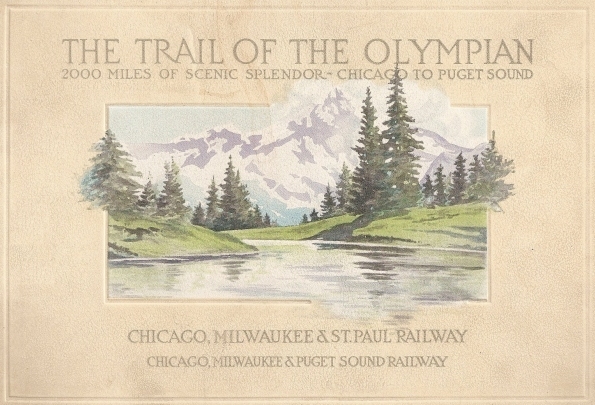
|
|
|
 |
|
|
|
|
|
MORE than a century ago the first white men blazed a trail through the great Northwest from the Mississippi Valley to the Pacific North Coast, claiming for the Nation a vast Inland Empire. Today a new transcontinental line, the Chicago, Milwaukee & St. Paul and Chicago, Milwaukee & Puget Sound Railways, opening boundless resources still untouched in the magnificent region discovered, testifies to the enduring work of the Pioneer. Among the wonders of their day stands the marking of the Old Trail. Among the wonders of today stands the building of the New Trail. Less than three years after work was started a great steel highway was built, setting a record in the annals of railway construction. In the old days railroad builders sought the easiest way regardless of time, grades and distance. The new road looked to the future. It sought the shortest and most enduring way. Its 60,000,000 cubic yards of excavation, more than one-third that of the Panama Canal; its 10 miles of rock-hewn tunnels, its 20 miles of steel and concrete bridges, its 200,000 tons of heaviest steel rails, its rock ballast, its lowest grades, tell of success. Over this solid, smooth-riding roadbed two palatial transcontinental trains, "The Olympian" and "The Columbian" are operated daily between Chicago, Seattle and Tacoma. Amid luxury and ease, afforded by these splendid trains, one traverses the most bewildering scenery. The "St. Paul-Puget Sound" road is the scenic highway to the Pacific North Coast. It threads the most magnificent regions of the great plains, the fertile valleys and the majestic mountain ranges of the Northwest. Northward from Chicago the trail leads through one of the richest truck-gardening and general farming regions of America to Milwaukee, thence westward crossing the Wisconsin River in full view of the famous "Dells," to the Mississippi, following the banks of the "Father of Waters," amid beauties unsurpassed to St. Paul and Minneapolis. Turning westward from the Twin Cities the line traverses the rich Dakota grain fields and unrivaled valleys of Montana with their thriving cities, young in years but old in achievements. Three mountain ranges rise in successive waves of grandeur, conquered by engineering feats unparalleled in railroad building – first the Rockies, rising to the crest of the continent, the great divide; then the forested Bitter Roots, and lastly the Cascades, snow-tipped and jagged. Beyond lies the giant amphitheater of the Puget Sound, Seattle and Tacoma in its center, commanding its splendors. This is a book of picture writing. Words grow powerless and trite when set to the task of portraying nature in her supremities; but the language of pictures is different, snatching up as it were bits of reality to speak with vigor ever fresh and meaningful. The story told is of the scenic road across the continent. Many highways share its goal, but for him who would see his country's beauties there lies magnificent and alluring "The Trail of the Olympian." |
|
|
|
|
|
Copyright F. A. Miller 1912 |
|
|
|
|
| web version |
reformatted document, viewable as web pages |
|
|
| Click here for a guide to this website |
|
|
| Last Updated: October 16, 2007 |